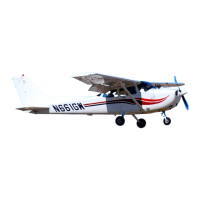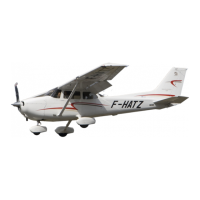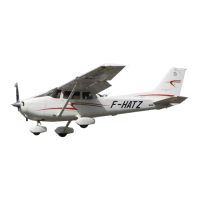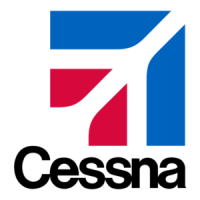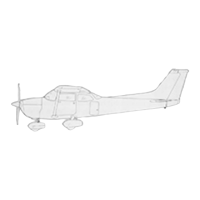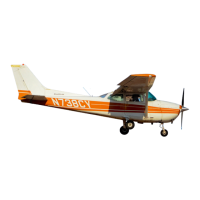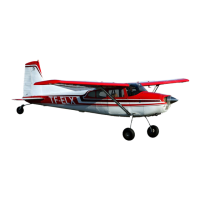Do you have a question about the Cessna SKYHAWK and is the answer not in the manual?
Company overview and location details.
Identifies the Cessna Model 172 and Skyhawk.
Details on aircraft weight, cruise, and range capabilities.
Specifies take-off run and landing distances.
Information on empty weight, baggage, and fuel/oil capacity.
Required fuel grade and engine oil types and grades.
Specifications for hydraulic fluid and tire inflation.
Maintenance for the nose gear shock strut.
Details of warranty coverage and duration for aircraft parts.
Conditions and exclusions from warranty coverage.
Guidance on using the owner's manual for optimal experience.
Overview of services provided by Cessna dealers.
Diagrams illustrating the aircraft's main physical dimensions.
Step-by-step guide for the exterior pre-flight inspection.
Additional notes and checks for exterior inspection.
Checklist items prior to boarding the aircraft.
Checklist items before engine start.
Detailed steps for starting the aircraft engine.
Essential checks before initiating take-off.
Guidance for normal and maximum performance take-offs.
Recommended airspeeds and data for climbing.
Procedures and settings for efficient cruising flight.
Steps for descending the aircraft.
Pre-landing checks and configuration.
Instructions for normal, short field, and crosswind landings.
Procedure for aborting a landing.
Steps to safely secure the aircraft after landing.
Using the gauge to detect carburetor icing.
Procedures to prevent fuel vapor issues.
Methods to restore power if irregularities occur.
Identification of instruments on the panel.
Actions to take in case of aircraft malfunction.
Important operational considerations for systems.
Description and operation of the wing leveler.
Explanation of the aircraft's fuel supply system.
Diagram of the aircraft fuel system.
Operation of the true airspeed indicator.
Description of the fuel sampling kit.
Operation of transmitter, speaker, and autopilot switches.
Description of the aircraft's electrical power system.
Function of ammeter and circuit breakers/fuses.
Operation of optional landing lights.
Schematic diagram of the aircraft's electrical system.
How to operate radio selector switches.
Details on ground power and static pressure alternate source.
Operation of cabin heating, ventilation, and optional lights.
Steps for starting the engine, including pre-heating.
Information on extended range fuel tank systems.
Details on winterization kits and their use.
Guidelines for safe taxiing.
Chart showing maximum glide distance.
Diagram illustrating taxiing maneuvers with wind.
Procedures for engine warm-up and magneto checks.
Ensuring engine readiness for take-off.
Table of landing distances under various conditions.
Tables detailing cruise speeds and range.
Recommended flap settings for take-off.
Techniques for take-offs in crosswind conditions.
Data for climb performance at different altitudes.
Factors affecting cruise efficiency.
Tables for take-off distances.
Data on maximum climb rates.
Adjusting indicated airspeed to true airspeed.
Achieving best fuel efficiency in cruise.
Stall speeds with power off.
Information on using performance charts for flight planning.
Guidance on various landing types.
Specific techniques for challenging landings.
Procedure for aborting a landing.
Cessna's system for owner notifications.
List of additional manuals and guides.
Specific procedures for starting in cold temperatures.
Engine starting steps without pre-heating.
Notes on operating in cold weather.
Maintenance tasks required every 500 operating hours.
Maintenance tasks performed as needed.
Initial maintenance after 25 hours of operation.
Maintenance tasks required every 50 operating hours.
Maintenance tasks required every 100 operating hours.
Daily checks for fuel system components.
Daily checks for engine oil level and filling.
Documents required in the aircraft file.
Approved flight operations and categories.
Permitted maneuvers in the normal category.
Permitted maneuvers in the utility category.
Certificated calibrated airspeed limits.
Methods for cleaning aircraft interior surfaces.
Schedule for aircraft inspections.
Color-coded ranges on the airspeed indicator.
Limits for engine power and speed.
Steps to determine aircraft weight and balance.
Cleaning and maintaining aluminum exterior surfaces.
Pre-flight checks and maintenance for the propeller.
Proper methods for cleaning plastic windshields.
Maintaining the aircraft's painted exterior.
Recommended schedule for inspections and maintenance.
Safe methods for maneuvering the aircraft on the ground.
Procedures for securing the aircraft against weather.
Company overview and location details.
Identifies the Cessna Model 172 and Skyhawk.
Details on aircraft weight, cruise, and range capabilities.
Specifies take-off run and landing distances.
Information on empty weight, baggage, and fuel/oil capacity.
Required fuel grade and engine oil types and grades.
Specifications for hydraulic fluid and tire inflation.
Maintenance for the nose gear shock strut.
Details of warranty coverage and duration for aircraft parts.
Conditions and exclusions from warranty coverage.
Guidance on using the owner's manual for optimal experience.
Overview of services provided by Cessna dealers.
Diagrams illustrating the aircraft's main physical dimensions.
Step-by-step guide for the exterior pre-flight inspection.
Additional notes and checks for exterior inspection.
Checklist items prior to boarding the aircraft.
Checklist items before engine start.
Detailed steps for starting the aircraft engine.
Essential checks before initiating take-off.
Guidance for normal and maximum performance take-offs.
Recommended airspeeds and data for climbing.
Procedures and settings for efficient cruising flight.
Steps for descending the aircraft.
Pre-landing checks and configuration.
Instructions for normal, short field, and crosswind landings.
Procedure for aborting a landing.
Steps to safely secure the aircraft after landing.
Using the gauge to detect carburetor icing.
Procedures to prevent fuel vapor issues.
Methods to restore power if irregularities occur.
Identification of instruments on the panel.
Actions to take in case of aircraft malfunction.
Important operational considerations for systems.
Description and operation of the wing leveler.
Explanation of the aircraft's fuel supply system.
Diagram of the aircraft fuel system.
Operation of the true airspeed indicator.
Description of the fuel sampling kit.
Operation of transmitter, speaker, and autopilot switches.
Description of the aircraft's electrical power system.
Function of ammeter and circuit breakers/fuses.
Operation of optional landing lights.
Schematic diagram of the aircraft's electrical system.
How to operate radio selector switches.
Details on ground power and static pressure alternate source.
Operation of cabin heating, ventilation, and optional lights.
Steps for starting the engine, including pre-heating.
Information on extended range fuel tank systems.
Details on winterization kits and their use.
Guidelines for safe taxiing.
Chart showing maximum glide distance.
Diagram illustrating taxiing maneuvers with wind.
Procedures for engine warm-up and magneto checks.
Ensuring engine readiness for take-off.
Table of landing distances under various conditions.
Tables detailing cruise speeds and range.
Recommended flap settings for take-off.
Techniques for take-offs in crosswind conditions.
Data for climb performance at different altitudes.
Factors affecting cruise efficiency.
Tables for take-off distances.
Data on maximum climb rates.
Adjusting indicated airspeed to true airspeed.
Achieving best fuel efficiency in cruise.
Stall speeds with power off.
Information on using performance charts for flight planning.
Guidance on various landing types.
Specific techniques for challenging landings.
Procedure for aborting a landing.
Cessna's system for owner notifications.
List of additional manuals and guides.
Specific procedures for starting in cold temperatures.
Engine starting steps without pre-heating.
Notes on operating in cold weather.
Maintenance tasks required every 500 operating hours.
Maintenance tasks performed as needed.
Initial maintenance after 25 hours of operation.
Maintenance tasks required every 50 operating hours.
Maintenance tasks required every 100 operating hours.
Daily checks for fuel system components.
Daily checks for engine oil level and filling.
Documents required in the aircraft file.
Approved flight operations and categories.
Permitted maneuvers in the normal category.
Permitted maneuvers in the utility category.
Certificated calibrated airspeed limits.
Methods for cleaning aircraft interior surfaces.
Schedule for aircraft inspections.
Color-coded ranges on the airspeed indicator.
Limits for engine power and speed.
Steps to determine aircraft weight and balance.
Cleaning and maintaining aluminum exterior surfaces.
Pre-flight checks and maintenance for the propeller.
Proper methods for cleaning plastic windshields.
Maintaining the aircraft's painted exterior.
Recommended schedule for inspections and maintenance.
Safe methods for maneuvering the aircraft on the ground.
Procedures for securing the aircraft against weather.
| Manufacturer | Cessna |
|---|---|
| Model | 172 Skyhawk |
| Engine | Lycoming IO-360-L2A |
| Horsepower | 160 hp |
| Cruise Speed | 124 knots (143 mph, 230 km/h) |
| Range | 696 nmi (801 mi, 1, 289 km) |
| Length | 27 ft 2 in (8.28 m) |
| Height | 8 ft 11 in (2.72 m) |
| Maximum Takeoff Weight | 2, 450 lb (1, 111 kg) |
| Seating Capacity | 4 |
| Service Ceiling | 14, 000 feet |
| Wingspan | 36 ft 1 in (11.0 m) |
| Fuel Capacity | 56 US gallons (212 litres) |
| Maximum Speed | 140 knots |
